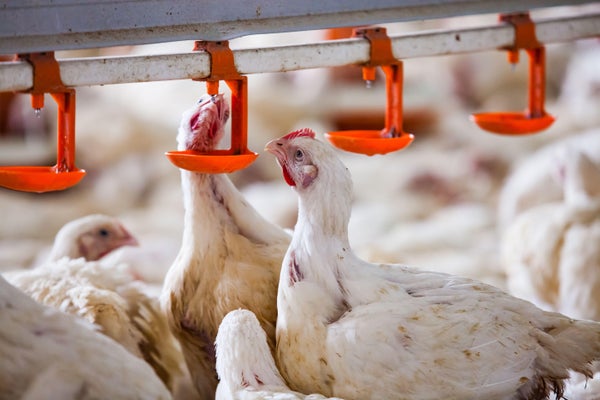
CRISPR Will Likely Not Solve Bird Flu
New research shows that CRISPR, the gene editing technique, could make chickens more resistant to bird flu. But its use raises many ethical and scientific issues

Credit: Alexey Rezvykh/Alamy Stock Photo
Recently, a group of scientists announced a breakthrough approach to combat Highly Pathogenic Avian Influenza (bird flu or avian flu), a severe illness of birds that has killed millions of chickens worldwide since it emerged in 1996 and continues to devastate bird populations. This disease has quickly become a potential threat to human health and has affected both food prices and availability.
Their approach uses a gene-editing technique called CRISPR/Cas9. In general, this method changes defined segments of an animal’s genetic code to functionally alter what that code does. In this case, CRISPR was used to alter chickens’ genetic code to make chickens more resistant to avian flu. While this was a fascinating use of the technology, any time scientific innovation affects the food we eat, it becomes a sensitive issue. On top of philosophical concerns regarding the use of CRISPR within our food supply, we think there are too many unpredictable outcomes related to combating avian influenza with CRISPR-modified chickens to expect this technology will be a solution to this destructive disease.
While CRISPR has created almost infinite opportunities to address some of the health-related challenges facing society, including recent therapies for sickle cell disease in humans, it’s not likely to be successful in controlling avian influenza. All avian influenza viruses originate in waterfowl, such as ducks, which serve as a constant source of potentially new viruses to infect poultry populations. Avian flu viruses also readily change—or mutate—their genetic material, allowing the viruses to quickly adapt to different hosts beyond poultry. This ability to quickly evolve also rapidly changes the way the virus spreads, making it challenging to control and the impact of any intervention difficult to foresee.
On supporting science journalism
If you’re enjoying this article, consider supporting our award-winning journalism by subscribing. By purchasing a subscription you are helping to ensure the future of impactful stories about the discoveries and ideas shaping our world today.
For example, in 2015 and 2022, avian flu spread to the U.S., causing unprecedented outbreaks in poultry that resulted in the death of millions of birds, leading to shortages of poultry products and more expensive eggs. In 2014 and 2015, a strain of avian flu virus that was new to North America made its way to the West Coast from Eurasia and caused dramatic and widespread disease outbreaks in poultry before disappearing in the summer of 2015. In 2022, a related strain made its way to the East Coast of North America causing an even wider spread and more devastating outbreak.
The 2022 virus has developed a different survival strategy by persisting in waterfowl populations for longer periods and over different life stages. And although our current control approaches—such as destruction of infected and nearby poultry, increased testing in areas surrounding infected farms, and restrictions on the movements of animals and their products—are imperfect, the magnitude of these outbreaks would not have changed if there had been CRISPR-modified chickens on farms because the outbreaks were and are likely to still be driven by virus introductions from wild ducks.
This combination of genetic variability and the wide variety of birds and mammals that can be infected with avian flu will make it very difficult to predict the outcome of using CRISPR to increase the resistance of chickens to infection with avian flu. There is a real chance for unintended or unpredictable consequences. For example, as soon as the virus has trouble infecting CRISPR-modified chickens, it will change and adapt. While most changes won’t help the virus survive, there might be one among the billions of changes that will. Such a mutation could lead to a more deadly outbreak of avian flu in chickens, which could be catastrophic for this segment of our food supply. And it’s possible that one of the billions of changes that make it easier for the virus to survive in CRISPR-modified chickens could also make it more likely to be able to infect mammals including humans.
So, even though we understand a lot about influenza viruses, there’s even more we don’t understand.
Finally, in addition to all the virological implications of using CRISPR to alter chickens’ susceptibility to avian flu we need to consider how people might perceive this technology within the food supply. The companies that grow poultry are not only experts in animal husbandry and welfare but also in marketing and product differentiation, and sometimes use language that creates consumer confusion and misperception. For instance, in the U.S., it is illegal to feed hormones to poultry or pigs, yet companies label their products as being “no hormones added” in an attempt to suggest that other companies might be doing so. We can envision one company advertising their “influenza-resistant” chickens as more environmentally sustainable to sway consumers, while another company might respond by warning consumers of the dangers of genetic engineering to create the perception that their non–genetically engineered chickens are “safer” for human consumption. Such marketing techniques are already in use around other genetically modified (or, as they’re now labeled, “bioengineered”) agricultural products, such as corn, canola, soybeans and sugar beets.
That being said, scientific innovation plays a crucial role in addressing the grand challenges of climate change, food safety and carbon footprint reduction across all types of food production. We should use CRISPR to improve the environmental and economic sustainability of production, but any company or research group using genetic engineering techniques to modify the food we eat needs to be clear about the effects of these innovations to ensure public trust. We cannot create an opportunity for failure, or we will not have another chance.
Avian flu outbreaks threaten animal health, human health and food security, and we need to develop better prevention strategies and promote accepted strategies such as vaccination to keep this aspect of our food supply stable. But using CRISPR to alter chickens to be more resistant to avian flu is not the way to go.
This is an opinion and analysis article, and the views expressed by the author or authors are not necessarily those of Scientific American.
Source link



